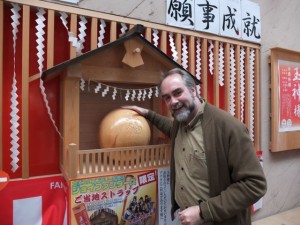Arcades are still popular in Japan and they offer a gaming experience different from the small arcades in airports in Canada. Associate Professor Keiji Amano and his wife took me for a tour of arcades in Nagoya on November 25th and commented on a draft of this post. We visited a variety of arcades including a Pachinko parlour, a floor of claw and crane games in an arcade complex along with a floor of “hard-core” arcade games, and a family oriented arcade in a shopping mall. We also visited a large shop to check out fan dojinshi manga and a card trading/play shop. I’ve posted my photos in a set on Flickr with some comments.
I took the Shinkasen (bullet) train to Nagoya which has nothing to dowith games, but is an impressive and convenient way to travel here. The train sounds like a plane as it speeds up shooting past suburbs and farms. At Nagoya I met Keiji and Saori Amano who both enjoy games and still visit the local arcades (at least they visit them with academic colleagues.) Keiji is an Associate Professor in the Faculty of Business Administration at Seijoh University. He studys business clusters but also teaches using serious games and is working with students and the local business association to develop a locative game for Tokai city, located on the outskirts of Nagoya.

The first stop in our tour was a Pachinko parlour or arcade. I’m going to write about Pachinko in depth another day as a bunch of us are planning a field trip together to see Pachinko arcades in Kyoto and talk about them. Pachinko and video-slot terminals are not usually considered games, they really a form of gambling here, but they are important to understanding arcades in Japan because there are so many parlours. On this trip I was interested in shooting pictures of the colourful interfaces to the games, understanding the transmedia aspects of Pachinko and to taking pictures of the spaces around the corridors of Pachinko games. The parlour we saw had a lounge area for
resting and a food area where you could buy snacks between games using the Pachinko balls or tokens won. There were displays of the swag you can buy with your winning balls and apparently trade back somewhere else for money or bring back home as souvenirs. I also found a pamphlet that explained Pachinko in English which you can see in my photos.
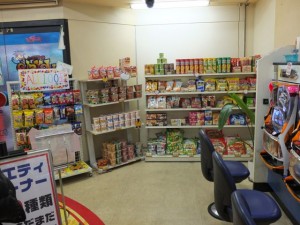
Keiji explained that for a man who has a family, buying food and souvenirs is a typical excuse for wasting his time and money.
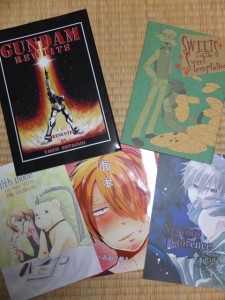
The second stop was a branch of the Mandrake chain that specialize in collectibles and fan manga among other things. I couldn’t take pictures in the store due to company policy (actually I did take pictures but someone ran after me and asked me to delete them which I did.) On the ground floor of the store there were large glass cabinets with collectibles of all sorts, mostly related to popular culture. There were old toys, Astro Boy figures, and plastic monsters. A few floors up there were cosplay costumes for sale and it seemed like there might even be a seamstress on duty to adapt them. What particularly interested me were the dojininshi (fan) manga of which there was a large section. These manga are produced by amateurs using characters from popular franchises. The amateurs organize into circles and publish their works for others to buy at stores like Mandrake or at large shows like the Tokyo Comiket (“comic market”). The manga were organized by the titles of the franchises that they draw from. I picked up one based on Miyazaki’s Sherlock Hound, one based on Evangelion, one based on Gundam, and one based on Hetalia.
The Hetalia fan manga is one of the strangest. The original series is bizarre – the characters are all stereotypes for various Allied and Axis countries and they get into silly semi-historical situations. The fanzine I picked up takes an erotic turn (as many fan manga do) showing a homoerotic interaction between the US character and the Canadian character (who carries around a polar white teddy.) I’m told these homoerotic or yaoi manga portraying young men in endless love are usually created by women for women.
You can see the sort of stuff carried at the Mandrake online store, http://ekizo.mandarake.co.jp/shop/en/.
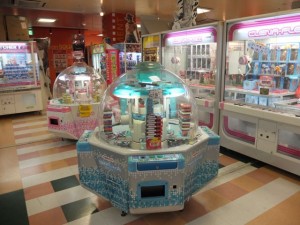
The next stop was at an arcade complex of many floors. The ground floor had claw and crane games. This floor of the arcade was well lit and wide open. The Japanese love claw games and some people must get good enough to win prizes. Each claw game had a theme to the prizes you could win. I imagine people play the game with the swag they want. Brian Ashcraft in Arcade Mania has a nice section on these types of games.
Keiji sent me link to the SEGA official website that has a “UFO Catcher” claw Flash game you can play, http://segaprize.com/amuse/ufo/. While the site is in Japanese you can still play the game by clicking on the obvious buttons. Keiji further explained,
Basically, the games shouldn’t provide prizes as a result of the game (Entertainment Business Control Law). But those crane and claw games were in vogue when the market was loosely regulated by the Entertainment Business Control Law and at that time those games has already become indispensable games to game center profits. Yes, we love those games. (Afterwards, some industry groups developed guidelines for those games, and the police department certified it as an exception).
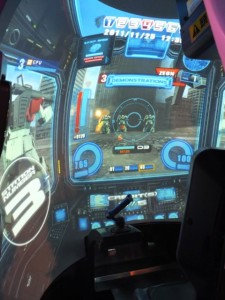
The second floor was where the hard-core arcade games were, if one can call them that. The floor, by contrast to the well lit first floor was dark and smoky. Most of the games came in sets and were networked so you could play people elsewhere in the country. There were rythm games, shooters, Mahjong, horse racing, soccer, card enabled games and, of course, Gundam. The Gundam Mobile Suit Battlefield system was the most impressive. To play you have to first get a Pilot Card so your experience can be tracked and you can be matched with appropriate other players. You then go to one of the pods (panoramic optical display) organized in a horseshoe around the card terminal. There you insert your card, drop in coins and play in matches that pit a Federation team against a Zeon team (you can choose either.) The pod has a projector over your head that projects an immersive display as
if you were in the cockpit of one of the mobile suits.
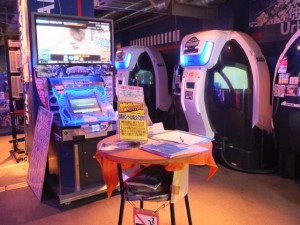
Keiji afterwards sent me this link to a YouTube video introducing the system that has English subtitles, http://www.youtube.com/watch?v=CWnNtUCngXw.
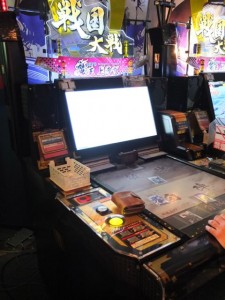
Another interesting type of game was the card-based games – a type ofgame I haven’t seen in Canada though I haven’t been to the Playdium ina while. (The Playdium in Missisauga is the closest I can think of to a Japanese arcade.) These use computer readable cards that you buy, collect and play with. They have surfaces on which you put your cards which may represent warriors you can deploy or soccer stars. Again these games are networked so you could be playing people in other arcades. These systems bridge card-only games like Magic and networked
computer games. Arcade Mania has a section on these.
There were also rythm games like Jubeat (http://en.wikipedia.org/wiki/Jubeat) which we played and a Dance
Dance Revolution station that was being repaired. The DDR station was placed right at the entrance and had cordons to manage crowds. I assume it is a crowd pleaser that draws people into the dark and smocky den of gaming. (Yes, you can smoke in the Japanese arcades, even the family ones.)
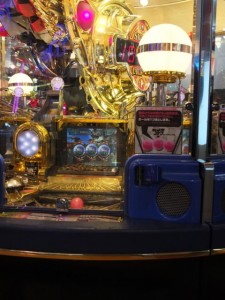
After this game center (as the Japanese call arcades) we went to a shopping mall that had a large arcade area on one of the upper floors. This area was well lit with high ceilings as it was more of a family arcade area. You could still smoke in the area, but the games tended to be aimed more at older folk and women. There were video-slots.
Gambling games from video-slots to Pachinko are popular with older generations and the Japanese don’t seem to worry about children around these games. There were a number of claw and crane games and some elaborate coin-pusher games. Some of the coin-pusher games were built around large Rube Goldberg machines with balls that could be launched to roll around and, if lucky, drop into the table of coins helping push more coins into your tray. Visually these were mesmerizing in their complexity like the machines you find at science centers. I couldn’t understand all that was going on in these coin pushers, which is probably the point, they entertain in their complexity. I’m also guessing that to keep players these games need to be complex enough that players will continue playing to figure them out. Like crane games they offer hope that one can get to the point of being able to win often enough through experience.
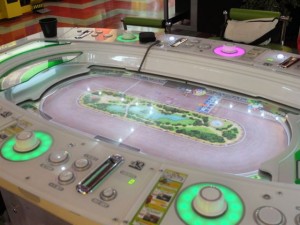
As in the other arcade there were multi-player horse racing games arranged as rows of seats before a large screen where the horse races play out. More interesting from an interface perspective was a table-top horse racing game with stations around the table and a screen flat in the middle showing the track.
And so, after a day in the arcades I caught the bullet train back to Kyoto to decompress and sort through my images. It would be interesting to track the evolution of arcade games and see how they have adapted as more and more powerful consoles become available. I was intrigued by how many of the games came in networked banks of games so you can play others in the room or over the network. I wonder if rankings are important to players or if they like to play in groups.
My thanks to Keiji Amano and his wife for their help and comments.
